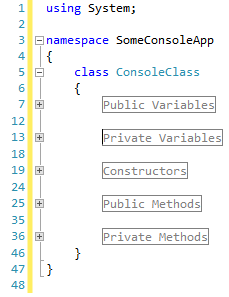Using #region Effectively
The #region preprocessor directive can make your C# code very organized. It is a shame that so many coders do not learn to use #region early and often. Sure #region allows Visual Studio 2010 to collapse your code block down into one-line, but better yet it can be used to sort code by common sections. This provides a framework for other source files throughout your project to mimic. Today I wanted to cover how I like to sort my code in my projects.
Many of your C# classes, interfaces, and other source files will have common logical groupings. For example many classes will contain one or more of the following:
- Public Variables
- Private Variables
- Constructors
- Public Methods
- Private Methods
So using that as our #region framework we can develop a skeleton C# class file that follows that concept:
using System;
namespace SomeConsoleApp
{
class ConsoleClass
{
#region Public Variables
/* ...Here Be Dragons... */
#endregion
#region Private Variables
/* ...Here Be Secret Dragons... */
#endregion
#region Constructors
/* ...Here Be Dragon Eggs... */
#endregion
#region Public Methods
public void BreatheFire()
{
/* ...Magic Goes Here... */
}
// ...other public methods...
#endregion
#region Private Methods
private void RebuildFireBreath()
{
/* ...Some Secret Magic Goes Here... */
}
// ...other private methods...
#endregion
}
}
So if you were to plug-in the C# example from above, you could collapse your sections down so your editor looks like this:
If you are good about keeping your code clean a system like this can be invaluable to you. A system like my example will let you quickly move from file to file knowing where all the important chunks of code are, and allow you to “ignore” other sections since they will be collapsed already.
This is just one way to structure your project. You can of course re-order your blocks into however you see fit, and if you do you should leave a comment and tell me how you prefer to organize your source files.
So go ahead and give it a try in your next project!
